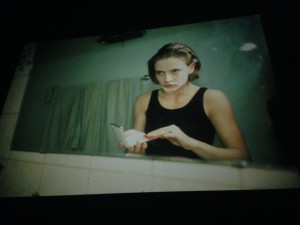Nan Goldin’s “Ballad” Resonates at MoMA
*All images are from The Ballad of Sexual Dependency, Nan Goldin, 1979-2004, Multimedia installation with 690 slides and a programmed soundtrack at the Museum of Modern Art, New York.
On view between now and February 12, 2017 at the Museum of Modern Art is The Ballad of Sexual Dependency, Nan Goldin’s landmark ode to Downtown New York of the 70s and 80s. Presented in its entirety featuring close to seven hundred slides over its forty-minute run, Goldin’s work bridges the devastating with the hopeful.
Captured over a period between her move to New York from Boston in the late 70s and mid 80s when AIDS crisis had its toll on the village, the ballad—the title is borrowed from a song in The Three Penny Opera—sure is about dependency, to one another, to drugs or to the night; however, more is to be traced in Goldin’s earthy-toned, sometimes blurred or saliently brisk pictures of her circle of friends and their friends, and strangers as well.
There are mirrors, mostly revealing bitter features, bruises or swells their onlookers carry, or other times uninvitedly reflecting a break-up or an overdose from a corner of a cluttered East Village apartment. Suitably, Nico begins to hum I’ll Be Your Mirror while mirrors come to utter what the camera observes or misses. There are also windows, trains and stoops, accompanying the New York silhouette that people are either leaving from or returning to. Charles Aznavour says “you’ve let yourself go” in Tu T’Laisses Aller swaying to those that are anonymous or named such as Cookie Mueller, Greer Lankton or David Wojnarowicz.
They grieve, buoy, perish or resist in their equally familiar and unprecedented universe. Goldin’s camera is affectionate and earnest: far from a documentary observant, she endures as much as any other. She stares into her own camera with a bruised eye in Nan one month after being battered, an auto portrait that stands to depict all other wounded and ones that harm.
Her diary, as she refers to the series, opens up with each slide like a sheet of paper. Some succumbed to AIDS, overdose or mishap, while others’ faiths remain mystery. The outcome is not of an importance anyhow. All Tomorrow’s Parties begins to chime midway through the slideshow inside the completely dimmed room at MoMA, ranting about a tomorrow yet to come or perhaps one that has already passed.
—











